List of birds of Pakistan
| Part of a series on |
| Wildlife of Pakistan |
|---|
 |
|
Biodiversity Fauna and Flora
|
|
Conservation Protected areas
|
|
Organizations National
Ministry of Environment (Pakistan) · Pakistan Environmental Protection Agency · Dhodial Pheasantry · Zoological Survey Department of Pakistan · Sindh Wildlife Department · Punjab Wildlife Department · Khyber Pakhtukhwa Wildlife Department · Baluchistan Wildlife Department · Gilgit Baltistan Wildlife Department · Himalayan Wildlife Foundation · National Institute of Oceanography (Pakistan) International
|
|
Related topics Ecoregions · Forestry · Fishing Agriculture · Tourism Botanical and Zoological gardens Environmental issues |
This is a list of the bird species recorded in Pakistan. The avifauna of Pakistan include a total of 786 species, of which 39 are rare or accidental. One species listed is extirpated in Pakistan and is not included in the species count. The chukar (Alectoris chukar) is the official national bird of Pakistan, and the shaheen falcon is the symbolic icon of the Pakistan Air Force and Pakistan Avicultural Foundation.
This list's taxonomic treatment (designation and sequence of orders, families and species) and nomenclature (common and scientific names) generally follow the conventions of The Clements Checklist of Birds of the World, 5th edition. The family accounts at the beginning of each heading reflect this taxonomy, as do the species counts found in each family account. Accidental species are included in the total species count for Pakistan.
The following tags have been used to highlight several categories. The commonly occurring native species do not fall into any of these categories.
- (A) Accidental - a species that rarely or accidentally occurs in Pakistan
- (Ex) Extirpated - a species that no longer occurs in Pakistan but exists in other places
Loons

Order: Gaviiformes Family: Gaviidae
Loons, The loons are the size of a large duck or small goose, which they somewhat resemble in shape when swimming. There are 5 species worldwide and 2 species are found in Pakistan.
- Black-throated diver, Gavia arctica
- Great northern diver, Gavia immer
Grebes

Order: Podicipediformes Family: Podicipedidae
Grebes are small to medium-large freshwater diving birds. They have lobed toes and are excellent swimmers and divers. However, they have their feet placed far back on the body, making them quite ungainly on land. There are 20 species worldwide and 5 species which occur in Pakistan.
- Little grebe, Tachybaptus ruficollis
- Red-necked grebe, Podiceps grisegena
- Great crested grebe, Podiceps cristatus
- Horned grebe, Podiceps auritus
- Eared grebe, Podiceps nigricollis
Shearwaters and petrels

Order: Procellariiformes Family: Procellariidae
The procellariids are the main group of medium-sized "true petrels", characterised by united nostrils with medium septum and a long outer functional primary.
- Jouanin's petrel, Bulweria fallax (A)
- Flesh-footed shearwater, Ardenna carneipes
- Wedge-tailed shearwater, Ardenna pacificus (A)
- Short-tailed shearwater, Ardenna tenuirostris (A)
- Persian shearwater, Puffinus persicus
Storm petrels

Order: Procellariiformes Family: Hydrobatidae
The storm petrels are relatives of the petrels and are the smallest seabirds. They feed on planktonic crustaceans and small fish picked from the surface, typically while hovering. The flight is fluttering and sometimes bat-like. There are 21 species worldwide and 1 species which occurs in Pakistan.
- Wilson's storm petrel, Oceanites oceanicus
Tropicbirds
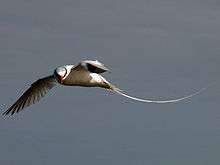

Order: Phaethontiformes Family: Phaethontidae
Tropicbirds are slender white birds of tropical oceans, with exceptionally long central tail feathers. Their heads and long wings have black markings.
- Red-billed tropicbird, Phaethon aethereus
- Red-tailed tropicbird, Phaethon rubricauda
Boobies and gannets

Order: Suliformes Family: Sulidae
The sulids comprise the gannets and boobies. Both groups are medium to large coastal seabirds that plunge-dive for fish.
- Masked booby, Sula dactylatra
Cormorants
Order: Suliformes Family: Phalacrocoracidae
Phalacrocoracidae is a family of medium to large coastal, fish-eating seabirds that includes cormorants and shags. Plumage colouration varies, with the majority having mainly dark plumage, some species being black-and-white and a few being colourful.
- Indian cormorant, Phalacrocorax fuscicollis
- Great cormorant, Phalacrocorax carbo
- Little cormorant, Microcarbo niger
- Pygmy cormorant, Microcarbo pygmeus
Darters
Order: Suliformes Family: Anhingidae
Darters are often called "snake-birds" because of their long thin neck, which gives a snake-like appearance when they swim with their bodies submerged. The males have black and dark-brown plumage, an erectile crest on the nape and a larger bill than the female. The females have much paler plumage especially on the neck and underparts. The darters have completely webbed feet and their legs are short and set far back on the body. Their plumage is somewhat permeable, like that of cormorants, and they spread their wings to dry after diving. There are 4 species worldwide and 1 species which occurs in Pakistan.
- Oriental darter, Anhinga melanogaster
Pelicans
Order: Pelecaniformes Family: Pelecanidae
Pelicans are large water birds with a distinctive pouch under their beak. As with other members of the order Pelecaniformes, they have webbed feet with four toes.
- Great white pelican, Pelecanus onocrotalus
- Grey pelican, Pelecanus philippensis
- Dalmatian pelican, Pelecanus crispus
Bitterns, herons and egrets
_at_Kolkata_I_IMG_2663.jpg)
Order: Pelecaniformes Family: Ardeidae
The family Ardeidae contains the bitterns, herons and egrets. Herons and egrets are medium to large wading birds with long necks and legs. Bitterns tend to be shorter necked and more wary. Members of Ardeidae fly with their necks retracted, unlike other long-necked birds such as storks, ibises and spoonbills.
- Grey heron, Ardea cinerea
- Goliath heron, Ardea goliath (A)
- Purple heron, Ardea purpurea
- Eastern great egret, Ardea modesta
- Intermediate egret, Egretta intermedia
- Western reef heron, Egretta gularis
- Little egret, Egretta garzetta
- Indian pond heron, Ardeola grayii
- Cattle egret, Bubulcus ibis
- Striated heron, Butorides striata
- Black-crowned night heron, Nycticorax nycticorax
- Yellow bittern, Ixobrychus sinensis
- Little bittern, Ixobrychus minutus
- Cinnamon bittern, Ixobrychus cinnamomeus
- Black bittern, Ixobrychus flavicollis
- Great bittern, Botaurus stellaris
Ibises and spoonbills

Order: Pelecaniformes Family: Threskiornithidae
Threskiornithidae is a family of large terrestrial and wading birds which includes the ibises and spoonbills. They have long, broad wings with 11 primary and about 20 secondary feathers. They are strong fliers and despite their size and weight, very capable soarers. There are 36 species worldwide and 4 species which occur in Pakistan.
- Black-headed ibis, Threskiornis melanocephalus
- Red-naped ibis, Pseudibis papillosa
- Glossy ibis, Plegadis falcinellus
- Eurasian spoonbill, Platalea leucorodia
Storks
.jpg)
Order: Ciconiiformes Family: Ciconiidae
Storks are large, long-legged, long-necked, wading birds with long, stout bills. Storks are mute, but bill-clattering is an important mode of communication at the nest. Their nests can be large and may be reused for many years. Many species are migratory.
- Painted stork, Mycteria leucocephala
- Asian openbill, Anastomus oscitans
- Black stork, Ciconia nigra
- Woolly-necked stork, Ciconia episcopus (A)
- White stork, Ciconia ciconia
- Black-necked stork, Ephippiorhynchus asiaticus
- Greater adjutant, Leptoptilos dubius (A)
Flamingos
.jpg)
Order: Phoenicopteriformes Family: Phoenicopteridae
Flamingos are gregarious wading birds, usually 3 to 5 feet (0.9 to 1.5 m) tall, found in both the Western and Eastern Hemispheres. Flamingos filter-feed on shellfish and algae. Their oddly shaped beaks are specially adapted to separate mud and silt from the food they consume and, uniquely, are used upside-down. There are 6 species worldwide and 2 species which occur in Pakistan.
- Greater flamingo, Phoenicopterus roseus
- Lesser flamingo, Phoenicopterus minor
Ducks, geese and swans

Order: Anseriformes Family: Anatidae
Anatidae includes the ducks and most duck-like waterfowl, such as geese and swans. These birds are adapted to an aquatic existence with webbed feet, flattened bills, and feathers that are excellent at shedding water due to an oily coating.
- Fulvous whistling duck, Dendrocygna bicolor
- Lesser whistling duck, Dendrocygna javanica
- Mute swan, Cygnus olor
- Whooper swan, Cygnus cygnus
- Tundra swan, Cygnus columbianus
- Greater white-fronted goose, Anser albifrons
- Lesser white-fronted goose, Anser erythropus
- Greylag goose, Anser anser
- Bar-headed goose, Anser indicus
- Ruddy shelduck, Tadorna ferruginea
- Common shelduck, Tadorna tadorna
- Comb duck, Sarkidiornis melanotos
- Cotton pygmy goose, Nettapus coromandelianus
- Eurasian wigeon, Anas penelope
- Falcated duck, Anas falcata (A)
- Gadwall, Anas strepera
- Baikal teal, Anas formosa (A)
- Eurasian teal, Anas crecca
- Mallard, Anas platyrhynchos
- Spot-billed duck, Anas poecilorhyncha
- Northern pintail, Anas acuta
- Garganey, Anas querquedula
- Northern shoveler, Anas clypeata
- Marbled teal, Marmaronetta angustirostris
- Red-crested pochard, Netta rufina
- Common pochard, Aythya ferina
- Ferruginous pochard, Aythya nyroca
- Baer's pochard, Aythya baeri
- Tufted duck, Aythya fuligula
- Greater scaup, Aythya marila
- Long-tailed duck, Clangula hyemalis (A)
- White-winged scoter, Melanitta fusca
- Common goldeneye, Bucephala clangula
- Smew, Mergellus albellus
- Red-breasted merganser, Mergus serrator (A)
- Common merganser, Mergus merganser
- White-headed duck, Oxyura leucocephala
Osprey

Order: Accipitriformes Family: Pandionidae
The Pandionidae family contains only one species, the osprey. The osprey is a medium-large raptor which is a specialist fish-eater with a worldwide distribution.
- Osprey, Pandion haliaetus
Hawks, kites and eagles

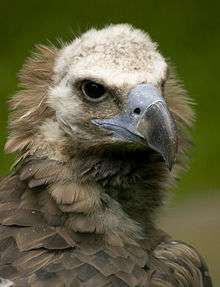
Order: Accipitriformes Family: Accipitridae
Accipitridae is a family of birds of prey, which includes hawks, eagles, kites, harriers and Old World vultures. These birds have powerful hooked beaks for tearing flesh from their prey, strong legs, powerful talons and keen eyesight.
- Crested honey buzzard, Pernis ptilorhynchus
- Black-shouldered kite, Elanus caeruleus
- Black kite, Milvus migrans
- Brahminy kite, Haliastur indus
- White-bellied sea eagle, Haliaeetus leucogaster
- Pallas's fish eagle, Haliaeetus leucoryphus
- White-tailed eagle, Haliaeetus albicilla
- Lammergeier, Gypaetus barbatus
- Egyptian vulture, Neophron percnopterus
- White-rumped vulture, Gyps bengalensis
- Indian vulture, Gyps indicus
- Himalayan griffon, Gyps himalayensis
- Eurasian griffon, Gyps fulvus
- Cinereous vulture, Aegypius monachus
- Red-headed vulture, Sarcogyps calvus
- Short-toed snake eagle, Circaetus gallicus
- Western marsh harrier, Circus aeruginosus
- Northern harrier, Circus cyaneus
- Pallid harrier, Circus macrourus
- Pied harrier, Circus melanoleucos
- Montagu's harrier, Circus pygargus
- Shikra, Accipiter badius
- Besra, Accipiter virgatus
- Eurasian sparrowhawk, Accipiter nisus
- Northern goshawk, Accipiter gentilis
- White-eyed buzzard, Butastur teesa
- Himalayan buzzard, Buteo burmanicus
- Long-legged buzzard, Buteo rufinus
- Oriental honey buzzard, Pernis ptilorhynchus
- Upland buzzard, Buteo hemilasius
- Black eagle, Ictinaetus malaiensis
- Lesser spotted eagle, Clanga pomarina
- Indian spotted eagle, Clanga hastata
- Greater spotted eagle, Clanga clanga
- Tawny eagle, Aquila rapax
- Steppe eagle, Aquila nipalensis
- Imperial eagle, Aquila heliaca
- Golden eagle, Aquila chrysaetos
- Bonelli's eagle, Aquila fasciata
- Booted eagle, Hieraaetus pennatus
- Mountain hawk-eagle, Nisaetus nipalensis
Caracaras and falcons
Order: Falconiformes Family: Falconidae
Falconidae is a family of diurnal birds of prey. They differ from hawks, eagles and kites in that they kill with their beaks instead of their talons. There are 62 species worldwide and 14 species which occur in Pakistan. Most species have declined rapidly due to their demand for the falcon hunting trade.
- Lesser kestrel, Falco naumanni
- Eurasian kestrel, Falco tinnunculus
- Red-necked falcon, Falco chicquera
- Amur falcon, Falco amurensis
- Sooty falcon, Falco concolor (A)
- Merlin, Falco columbarius
- Eurasian hobby, Falco subbuteo
- Oriental hobby, Falco severus
- Lanner falcon, Falco biarmicus
- Laggar falcon, Falco jugger
- Saker falcon, Falco cherrug
- Gyrfalcon, Falco rusticolus
- Shaheen falcon, Falco peregrinus peregrinator
- Barbary falcon, Falco pelegrinoides
- Peregrine falcon, Falco peregrinus—the breeding subspecies, peregrinator, is used in the logo of the Pakistani Air Force.
Pheasants and partridges
Order: Galliformes Family: Phasianidae
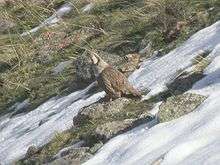



The Phasianidae are a family of terrestrial birds which consists of quails, partridges, snowcocks, francolins, spurfowls, tragopans, monals, pheasants, peafowls and jungle fowls. In general, they are plump (although they vary in size) and have broad, relatively short wings. There are 156 species worldwide and 17 species which occur in Pakistan. Of most species the numbers have declined considerably over the last decennia.
- Snow partridge, Lerwa lerwa
- Himalayan snowcock, Tetraogallus himalayensis
- Chukar, Alectoris chukar is the National bird of Pakistan.
- Sand partridge, Ammoperdix heyi
- See-see partridge, Ammoperdix griseogularis
- Black francolin, Francolinus francolinus
- Grey francolin, Francolinus pondicerianus
- Common quail, Coturnix coturnix
- Rain quail, Coturnix coromandelica
- Jungle bush-quail, Perdicula asiatica
- Western tragopan, Tragopan melanocephalus
- Koklass pheasant, Pucrasia macrolopha
- Himalayan monal, Lophophorus impejanus
- Red junglefowl, Gallus gallus
- Kalij pheasant, Lophura leucomelanos
- Cheer pheasant, Catreus wallichii
- Indian peafowl, Pavo cristatus
Cranes
Order: Gruiformes Family: Gruidae
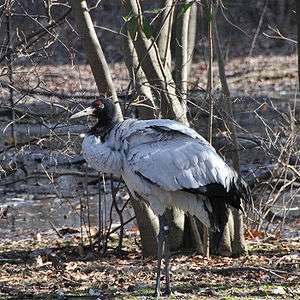
Cranes are large, long-legged and long-necked birds. Unlike the similar-looking but unrelated herons, cranes fly with necks outstretched, not pulled back. Most have elaborate and noisy courting displays or "dances". There are 15 species worldwide and 3 species which occur in Pakistan i.e. Demoiselle and common cranes which are migratory and the sarus crane which is resident. In this country numbers have declined as they are sought after as pet birds and hunted in the North-West in particular. The sarus crane which is found in abuntant numbers in India has almost disappeared in Pakistan although a lone pair was sighted in 2011 in the tharparker area after 10 years. This decline is due to hunting.
- Demoiselle crane, Anthropoides virgo
- Siberian crane, Grus leucogeranus
- Sarus crane, Grus antigone
- Tibetan crane, Grus nigricollis
- Common crane, Grus grus
Rails, crakes, gallinules and coots
Order: Gruiformes Family: Rallidae
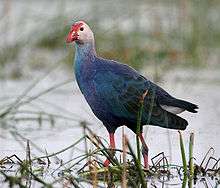
Rallidae is a large family of small to medium-sized birds which includes the rails, crakes, coots and gallinules. Typically they inhabit dense vegetation in damp environments near lakes, swamps or rivers. In general they are shy and secretive birds, making them difficult to observe. Most species have strong legs and long toes which are well adapted to soft uneven surfaces. They tend to have short, rounded wings and to be weak fliers.
- Slaty-legged crake, Rallina eurizonoides
- Slaty-breasted rail, Gallirallus striatus
- Water rail, Rallus aquaticus
- Brown crake, Amaurornis akool
- White-breasted waterhen, Amaurornis phoenicurus
- Little crake, Porzana parva
- Baillon's crake, Porzana pusilla
- Spotted crake, Porzana porzana
- Ruddy-breasted crake, Porzana fusca
- Watercock, Gallicrex cinerea
- Grey-headed swamphen, Porphyrio poliocephalus
- Common moorhen, Gallinula chloropus
- Eurasian coot, Fulica atra
Bustards
Order: Otidiformes Family: Otididae
Bustards are large terrestrial birds mainly associated with dry open country and steppes in the Old World. They are omnivorous and nest on the ground. They walk steadily on strong legs and big toes, pecking for food as they go. They have long broad wings with "fingered" wingtips and striking patterns in flight. Many have interesting mating displays. Their numbers have declined considerably due to hunting.
- Great bustard, Otis tarda
- Indian bustard, Ardeotis nigriceps (Ex)
- Houbara bustard, Chlamydotis undulata
- Macqueen's bustard, Chlamydotis macqueenii
- Lesser florican, Sypheotides indicus
- Little bustard, Tetrax tetrax
Buttonquails
Order: Charadriiformes Family: Turnicidae
The buttonquails are small, drab, running birds which resemble the true quails. The female is the brighter of the sexes and initiates courtship. The male incubates the eggs and tends the young.
- Small buttonquail, Turnix sylvatica
- Yellow-legged buttonquail, Turnix tanki
- Barred buttonquail, Turnix suscitator
Jacanas
Order: Charadriiformes Family: Jacanidae
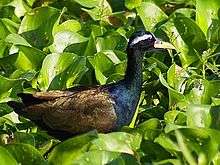
The jacanas are a group of tropical waders in the family Jacanidae. They are found throughout the tropics. They are identifiable by their huge feet and claws which enable them to walk on floating vegetation in the shallow lakes that are their preferred habitat. There 8 species worldwide and 2 species which occur in Pakistan.
- Pheasant-tailed jacana, Hydrophasianus chirurgus
- Bronze-winged jacana, Metopidius indicus
Painted-snipe
_I2_IMG_9477.jpg)
Order: Charadriiformes Family: Rostratulidae
Painted-snipe are short-legged, long-billed birds similar in shape to the true snipes, but more brightly coloured.
- Greater painted-snipe, Rostratula benghalensis
Crab-plover
Order: Charadriiformes Family: Dromadidae

The crab-plover is related to the waders. It resembles a plover but with very long grey legs and a strong heavy black bill similar to a tern. It has black-and-white plumage, a long neck, partially webbed feet and a bill designed for eating crabs.
- Crab-plover, Dromas ardeola
Oystercatchers
Order: Charadriiformes Family: Haematopodidae
The oystercatchers are large and noisy plover-like birds, with strong bills used for smashing or prising open molluscs. There are 11 species worldwide and 1 species which occurs in Pakistan.
- Eurasian oystercatcher, Haematopus ostralegus
Ibisbill
Order: Charadriiformes Family: Ibidorhynchidae

The ibisbill is related to the waders, but is sufficiently distinctive to be a family unto itself. The adult is grey with a white belly, red legs, a long down curved bill, and a black face and breast band.
- Ibisbill, Ibidorhyncha struthersii
Avocets and stilts

Order: Charadriiformes Family: Recurvirostridae
Recurvirostridae is a family of large wading birds, which includes the avocets and stilts. The avocets have long legs and long up-curved bills. The stilts have extremely long legs and long, thin, straight bills. There are 9 species worldwide and 2 species which occur in Pakistan.
- Black-winged stilt, Himantopus himantopus
- Pied avocet, Recurvirostra avosetta
Thick-knees
Order: Charadriiformes Family: Burhinidae
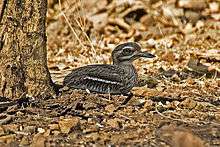
The thick-knees are a group of largely tropical waders in the family Burhinidae. They are found worldwide within the tropical zone, with some species also breeding in temperate Europe and Australia. They are medium to large waders with strong black or yellow-black bills, large yellow eyes and cryptic plumage. Despite being classed as waders, most species have a preference for arid or semi-arid habitats.
- Eurasian stone-curlew, Burhinus oedicnemus
- Indian stone-curlew, Burhinus indicus
- Great stone-curlew, Esacus recurvirostris
Pratincoles and coursers
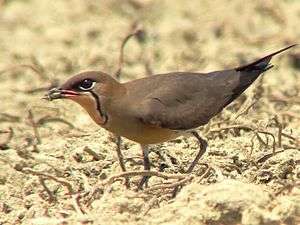

Order: Charadriiformes Family: Glareolidae
Glareolidae is a family of wading birds comprising the pratincoles, which have short legs, long pointed wings and long forked tails, and the coursers, which have long legs, short wings and long, pointed bills which curve downwards. There are 17 species worldwide and 5 species which occur in Pakistan.
- Cream-coloured courser, Cursorius cursor
- Indian courser, Cursorius coromandelicus
- Collared pratincole, Glareola pratincola
- Oriental pratincole, Glareola maldivarum
- Small pratincole, Glareola lactea
Plovers and lapwings

Order: Charadriiformes Family: Charadriidae
The family Charadriidae includes the plovers, dotterels and lapwings. They are small to medium-sized birds with compact bodies, short, thick necks and long, usually pointed, wings. They are found in open country worldwide, mostly in habitats near water. There are 66 species worldwide and 13 species which occur in Pakistan.
- Northern lapwing, Vanellus vanellus
- Yellow-wattled lapwing, Vanellus malabaricus
- Red-wattled lapwing, Vanellus indicus
- Sociable lapwing, Vanellus gregarius
- White-tailed lapwing, Vanellus leucurus
- Pacific golden-plover, Pluvialis fulva
- European golden-plover, Pluvialis apricaria
- Black-bellied plover, Pluvialis squatarola
- Common ringed plover, Charadrius hiaticula
- Little ringed plover, Charadrius dubius
- Snowy plover, Charadrius alexandrinus
- Lesser sandplover, Charadrius mongolus
- Greater sandplover, Charadrius leschenaultii
Sandpipers and allies
.jpg)
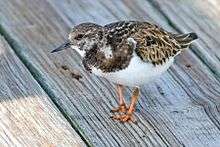
Order: Charadriiformes Family: Scolopacidae
Scolopacidae is a large diverse family of small to medium-sized shorebirds including the sandpipers, curlews, godwits, shanks, tattlers, woodcocks, snipes, dowitchers and phalaropes. The majority of these species eat small invertebrates picked out of the mud or soil. Variation in length of legs and bills enables multiple species to feed in the same habitat, particularly on the coast, without direct competition for food. There are 89 species worldwide and 30 species which occur in Pakistan.
- Eurasian woodcock, Scolopax rusticola
- Jack snipe, Lymnocryptes minimus
- Solitary snipe, Gallinago solitaria
- Wood snipe, Gallinago nemoricola
- Pintail snipe, Gallinago stenura
- Common snipe, Gallinago gallinago
- Black-tailed godwit, Limosa limosa
- Bar-tailed godwit, Limosa lapponica
- Whimbrel, Numenius phaeopus
- Eurasian curlew, Numenius arquata
- Spotted redshank, Tringa erythropus
- Common redshank, Tringa totanus
- Marsh sandpiper, Tringa stagnatilis
- Common greenshank, Tringa nebularia
- Green sandpiper, Tringa ochropus
- Wood sandpiper, Tringa glareola
- Terek sandpiper, Xenus cinereus
- Common sandpiper, Actitis hypoleucos
- Ruddy turnstone, Arenaria interpres
- Great knot, Calidris tenuirostris
- Red knot, Calidris canutus (A)
- Sanderling, Calidris alba
- Little stint, Calidris minuta
- Temminck's stint, Calidris temminckii
- Sharp-tailed sandpiper, Calidris acuminata (A)
- Curlew sandpiper, Calidris ferruginea
- Dunlin, Calidris alpina
- Broad-billed sandpiper, Limicola falcinellus
- Ruff, Philomachus pugnax
- Red-necked phalarope, Phalaropus lobatus
Skuas and jaegers
Order: Charadriiformes Family: Stercorariidae
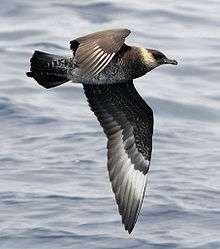
The family Stercorariidae are, in general, medium to large birds, typically with grey or brown plumage, often with white markings on the wings. They nest on the ground in temperate and arctic regions and are long-distance migrants. There are 7 species worldwide and 2 species which occur in Pakistan.
- Pomarine jaeger, Stercorarius pomarinus
- Parasitic jaeger, Stercorarius parasiticus
Gulls
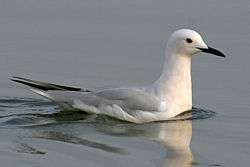
Order: Charadriiformes Family: Laridae
Laridae is a family of medium to large seabirds, the gulls and kittiwakes. They are typically grey or white, often with black markings on the head or wings. They have stout, longish bills and webbed feet.
- Common gull, Larus canus
- Lesser black-backed gull, Larus fuscus
- Heuglin's gull, Larus heuglini
- Vega gull, Larus vegae
- Caspian gull, Larus cachinnans
- Sooty gull, Ichthyaetus hemprichii
- Pallas's gull, Ichthyaetus ichthyaetus
- Brown-headed gull, Chroicocephalus brunnicephalus
- Black-headed gull, Chroicocephalus ridibundus
- Slender-billed gull, Chroicocephalus genei
Terns
Order: Charadriiformes Family: Sternidae
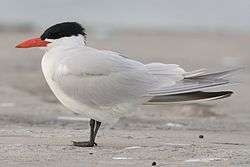
Terns are a group of generally medium to large seabirds typically with grey or white plumage, often with black markings on the head. Most terns hunt fish by diving but some pick insects off the surface of fresh water. Terns are generally long-lived birds, with several species known to live in excess of 30 years.
- Gull-billed tern, Gelochelidon nilotica
- Caspian tern, Hydroprogne caspia
- Lesser crested tern, Thalasseus bengalensis
- Sandwich tern, Thalasseus sandvicensis
- Great crested tern, Thalasseus bergii
- River tern (bird), Sterna aurantia
- Common tern, Sterna hirundo
- White-cheeked tern, Sterna repressa
- Black-bellied tern, Sterna acuticauda
- Little tern, Sternula albifrons (A)
- Saunders's tern, Sternula saundersi
- Bridled tern, Onychoprion anaethetus
- Whiskered tern, Chlidonias hybrida
- White-winged tern, Chlidonias leucopterus
- Brown noddy, Anous stolidus (A)
Skimmers
Order: Charadriiformes Family: Rynchopidae
Skimmers are a small family of tropical tern-like birds. They have an elongated lower mandible which they use to feed by flying low over the water surface and skimming the water for small fish. There are 3 species worldwide and 1 species which occurs in Pakistan.
- Indian skimmer, Rynchops albicollis
Sandgrouse

Order: Pterocliformes Family: Pteroclidae
Sandgrouse have small, pigeon like heads and necks, but sturdy compact bodies. They have long pointed wings and sometimes tails and a fast direct flight. Flocks fly to watering holes at dawn and dusk. Their legs are feathered down to the toes. There are 16 species worldwide and 7 species which occur in Pakistan.
- Pin-tailed sandgrouse, Pterocles alchata
- Chestnut-bellied sandgrouse, Pterocles exustus
- Spotted sandgrouse, Pterocles senegallus
- Black-bellied sandgrouse, Pterocles orientalis
- Crowned sandgrouse, Pterocles coronatus
- Lichtenstein's sandgrouse, Pterocles lichtensteinii
- Painted sandgrouse, Pterocles indicus
Pigeons and doves
Order: Columbiformes Family: Columbidae
Pigeons and doves are stout-bodied birds with short necks and short slender bills with a fleshy cere.
- Rock pigeon, Columba livia
- Hill pigeon, Columba rupestris
- Snow pigeon, Columba leuconota
- Yellow-eyed pigeon, Columba eversmanni
- Common wood pigeon, Columba palumbus
- Speckled wood pigeon, Columba hodgsonii
- European turtle dove, Streptopelia turtur (A)
- Oriental turtle dove, Streptopelia orientalis
- Eurasian collared dove, Streptopelia decaocto
- Red collared-dove, Streptopelia tranquebarica
- Spotted dove, Spilopelia chinensis
- Laughing dove, Spilopelia senegalensis
- Common emerald dove, Chalcophaps indica
- Ashy-headed green pigeon, Treron phayrei
- Yellow-footed green pigeon, Treron phoenicoptera
Old World parrots
Order: Psittaciformes Family: Psittaculidae

- Alexandrine parakeet, Psittacula eupatria
- Rose-ringed parakeet, Psittacula krameri
- Slaty-headed parakeet, Psittacula himalayana
- Plum-headed parakeet, Psittacula cyanocephala
Cuckoos and anis
Order: Cuculiformes Family: Cuculidae
The family Cuculidae includes cuckoos, roadrunners and anis. These birds are of variable size with slender bodies, long tails and strong legs. The Old World cuckoos are brood parasites.
- Pied cuckoo, Clamator jacobinus
- Large hawk-cuckoo, Hierococcyx sparverioides
- Common hawk-cuckoo, Hierococcyx varius
- Indian cuckoo, Cuculus micropterus
- Common cuckoo, Cuculus canorus
- Himalayan cuckoo, Cuculus saturatus
- Oriental cuckoo, Cuculus optatus (A)
- Lesser cuckoo, Cuculus poliocephalus
- Asian koel, Eudynamys scolopacea
- Sirkeer malkoha, Phaenicophaeus leschenaultii
- Greater coucal, Centropus sinensis
Barn owls
Order: Strigiformes Family: Tytonidae
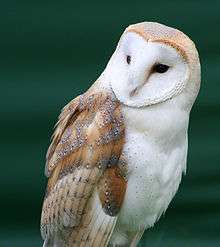
Barn owls are medium to large owls with large heads and characteristic heart-shaped faces. They have long strong legs with powerful talons. There are 16 species worldwide and 1 species which occurs in Pakistan.
- Barn owl, Tyto alba
Typical owls
Order: Strigiformes Family: Strigidae
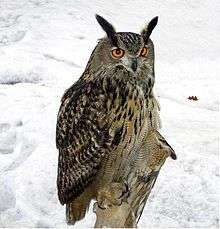
The typical owls are small to large solitary nocturnal birds of prey. They have large forward-facing eyes and ears, a hawk-like beak and a conspicuous circle of feathers around each eye called a facial disk.
- Indian scops owl, Otus bakkamoena
- Collared scops owl, Otus lettia
- Pallid scops owl, Otus brucei
- European scops owl, Otus scops
- Oriental scops owl, Otus sunia
- Eurasian eagle-owl, Bubo bubo
- Rock eagle-owl, Bubo bengalensis
- Dusky eagle-owl, Bubo coromandus
- Brown fish owl, Ketupa zeylonensis
- Mottled wood owl, Strix ocellata
- Brown wood owl, Strix leptogrammica
- Tawny owl, Strix aluco
- Himalayan owl, Strix nivicolum
- Desert owl, Strix hadorami
- Collared owlet, Glaucidium brodiei
- Asian barred owlet, Glaucidium cuculoides
- Little owl, Athene noctua
- Brown hawk-owl, Ninox scutulata
- Long-eared owl, Asio otus
- Short-eared owl, Asio flammeus
Nightjars
Order: Caprimulgiformes Family: Caprimulgidae
Nightjars are medium-sized nocturnal birds that usually nest on the ground. They have long wings, short legs and very short bills. Most have small feet, of little use for walking, and long pointed wings. Their soft plumage is camouflaged to resemble bark or leaves.
- Grey nightjar, Caprimulgus jotaka
- Eurasian nightjar, Caprimulgus europaeus
- Egyptian nightjar, Caprimulgus aegyptius
- Sykes's nightjar, Caprimulgus mahrattensis
- Large-tailed nightjar, Caprimulgus macrurus
- Indian nightjar, Caprimulgus asiaticus
- Savanna nightjar, Caprimulgus affinis
Swifts
Order: Apodiformes Family: Apodidae

Swifts are small birds which spend the majority of their lives flying. These birds have very short legs and never settle voluntarily on the ground, perching instead only on vertical surfaces. Many swifts have long swept-back wings which resemble a crescent or boomerang. There are 9 species which have been recorded in Pakistan.
- Himalayan swiftlet, Aerodramus brevirostris
- White-throated needletail, Hirundapus caudacutus
- Asian palm-swift, Cypsiurus balasiensis
- Alpine swift, Tachymarptis melba
- Common swift, Apus apus
- Pallid swift, Apus pallidus
- Blyth's swift, Apus leuconyx
- Little swift, Apus affinis
- House swift, Apus nipalensis
Kingfishers
Order: Coraciiformes Family: Alcedinidae
Kingfishers are medium-sized birds with large heads, long, pointed bills, short legs and stubby tails. There are 93 species worldwide and 5 species which occur in Pakistan.
- Common kingfisher, Alcedo atthis
- White-throated kingfisher, Halcyon smyrnensis
- Black-capped kingfisher, Halcyon pileata (A)
- Crested kingfisher, Megaceryle lugubris
- Pied kingfisher, Ceryle rudis
Bee-eaters
Order: Coraciiformes Family: Meropidae
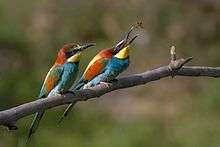
The bee-eaters are a group of near passerine birds in the family Meropidae. Most species are found in Africa but others occur in southern Europe, Madagascar, Australia and New Guinea. They are characterised by richly coloured plumage, slender bodies and usually elongated central tail feathers. All are colourful and have long downturned bills and pointed wings, which give them a swallow-like appearance when seen from afar. There are 26 species worldwide and 4 species which occur in Pakistan.
- Green bee-eater, Merops orientalis
- Blue-cheeked bee-eater, Merops persicus
- Blue-tailed bee-eater, Merops philippinus
- European bee-eater, Merops apiaster
Typical rollers
Order: Coraciiformes Family: Coraciidae

Rollers resemble crows in size and build, but are more closely related to the kingfishers and bee-eaters. They share the colourful appearance of those groups with blues and browns predominating. The two inner front toes are connected, but the outer toe is not. There are 12 species worldwide and 2 species which occur in Pakistan.
- European roller, Coracias garrulus
- Indian roller, Coracias benghalensis
Hoopoes
Order: Coraciiformes Family: Upupidae
Hoopoes have black, white and orangey-pink colouring with a large erectile crest on their head. There are 2 species worldwide and 1 species which occurs in Pakistan.
- Hoopoe, Upupa epops
Hornbills
Order: Coraciiformes Family: Bucerotidae

Hornbills are a group of birds whose bill is shaped like a cow's horn, but without a twist, sometimes with a casque on the upper mandible. Frequently, the bill is brightly coloured. There are 57 species worldwide and 1 species which occurs in Pakistan.
- Indian grey hornbill, Ocyceros birostris
Barbets
Order: Piciformes Family: Megalaimidae

The barbets are plump birds, with short necks and large heads. They get their name from the bristles which fringe their heavy bills. Most species are brightly coloured.
- Great barbet, Psilopogon virens
- Brown-headed barbet, Psilopogon zeylanicus
- Coppersmith barbet, Psilopogon haemacephalus
- Blue-throated barbet, Psilopogon asiaticus
Honeyguides
Order: Piciformes Family: Indicatoridae
Honeyguides are among the few birds that feed on wax. They are named for the greater honeyguide which leads traditional honey-hunters to bees' nests and, after the hunters have harvested the honey, feeds on the remaining contents of the hive. There are 17 species worldwide and 1 species which occurs in Pakistan.
- Yellow-rumped honeyguide, Indicator xanthonotus
Woodpeckers and allies
Order: Piciformes Family: Picidae

Woodpeckers are small to medium-sized birds with chisel-like beaks, short legs, stiff tails and long tongues used for capturing insects. Some species have feet with two toes pointing forward and two backward, while several species have only three toes. Many woodpeckers have the habit of tapping noisily on tree trunks with their beaks.
- Eurasian wryneck, Jynx torquilla
- Speckled piculet, Picumnus innominatus
- Brown-capped pygmy woodpecker, Yungipicus nanus
- Grey-capped pygmy woodpecker, Yungipicus canicapillus
- Brown-fronted woodpecker, Dendrocoptes auriceps
- Fulvous-breasted woodpecker, Dendrocopos macei
- Rufous-bellied woodpecker, Dendrocopos hyperythrus
- Sind woodpecker, Dendrocopos assimilis
- Himalayan woodpecker, Dendrocopos himalayensis
- Yellow-crowned woodpecker, Leiopicus mahrattensis
- Rufous woodpecker, Micropternus brachyurus
- Scaly-bellied woodpecker, Picus squamatus
- Grey-faced woodpecker, Picus canus
- Black-rumped flameback, Dinopium benghalense
Pittas
Order: Passeriformes Family: Pittidae
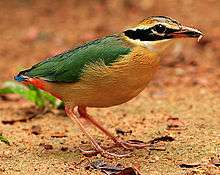
Pittas are medium-sized by passerine standards and are stocky, with fairly long, strong legs, short tails and stout bills. Many are brightly coloured. They spend the majority of their time on wet forest floors, eating snails, insects and similar invertebrates. There are 32 species worldwide and 1 species which occurs in Pakistan.
- Indian pitta, Pitta brachyura
Larks
Order: Passeriformes Family: Alaudidae
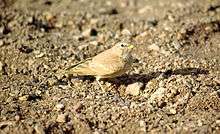
Larks are small terrestrial birds with often extravagant songs and display flights. Most larks are fairly dull in appearance. Their food is insects and seeds.
- Singing bushlark, Mirafra cantillans
- Indian bushlark, Mirafra erythroptera
- Black-crowned sparrow-lark, Eremopterix nigriceps
- Ashy-crowned sparrow-lark, Eremopterix grisea
- Bar-tailed lark, Ammomanes cincturus
- Rufous-tailed lark, Ammomanes phoenicurus
- Desert lark, Ammomanes deserti
- Greater hoopoe-lark, Alaemon alaudipes
- Bimaculated lark, Melanocorypha bimaculata
- Greater short-toed lark, Calandrella brachydactyla
- Hume's short-toed lark, Calandrella acutirostris
- Lesser short-toed lark, Alaudala rufescens
- Asian short-toed lark, Alaudala cheleensis
- Sand lark, Alaudala raytal
- Crested lark, Galerida cristata
- Eurasian skylark, Alauda arvensis
- Oriental skylark, Alauda gulgula
- Horned lark, Eremophila alpestris
Swallows and martins
Order: Passeriformes Family: Hirundinidae
_-_Flickr_-_Lip_Kee_(1).jpg)
The family Hirundinidae is adapted to aerial feeding. They have a slender streamlined body, long pointed wings and a short bill with a wide gape. The feet are adapted to perching rather than walking, and the front toes are partially joined at the base.
- Sand martin, Riparia riparia
- Pale martin, Riparia diluta
- Grey-throated martin, Riparia chinensis
- Eurasian crag martin, Ptyonoprogne rupestris
- Pale crag martin, Ptyonoprogne obsoleta
- Dusky crag martin, Ptyonoprogne concolor
- Barn swallow, Hirundo rustica
- Wire-tailed swallow, Hirundo smithii
- Red-rumped swallow, Cecropis daurica
- Streak-throated swallow, Petrochelidon fluvicola
- Common house martin, Delichon urbica
- Asian house martin, Delichon dasypus
Wagtails and pipits
Order: Passeriformes Family: Motacillidae

Motacillidae is a family of small passerine birds with medium to long tails. They include the wagtails, longclaws and pipits. They are slender, ground feeding insectivores of open country.
- White wagtail, Motacilla alba
- Black-backed wagtail, Motacilla lugens
- White-browed wagtail, Motacilla maderaspatensis
- Citrine wagtail, Motacilla citreola
- Yellow wagtail, Motacilla flava
- Grey wagtail, Motacilla cinerea
- Oriental pipit, Anthus rufulus
- Richard's pipit, Anthus richardi (A)
- Tawny pipit, Anthus campestris
- Blyth's pipit, Anthus godlewskii
- Long-billed pipit, Anthus similis
- Tree pipit, Anthus trivialis
- Olive-backed pipit, Anthus hodgsoni (A)
- Meadow pipit, Anthus pratensis
- Red-throated pipit, Anthus cervinus
- Rosy pipit, Anthus roseatus
- Water pipit, Anthus spinoletta
- Upland pipit, Anthus sylvanus
- American pipit, Anthus rubescens
Cuckooshrikes
Order: Passeriformes Family: Campephagidae

The cuckooshrikes are small to medium-sized passerine birds. They are predominantly greyish with white and black, although some species are brightly coloured. There are 82 species worldwide and 8 species which occur in Pakistan.
- Large cuckooshrike, Coracina macei
- Black-winged cuckooshrike, Coracina melaschistos
- Black-headed cuckooshrike, Coracina melanoptera
- Rosy minivet, Pericrocotus roseus
- Small minivet, Pericrocotus cinnamomeus
- White-bellied minivet, Pericrocotus erythropygius
- Long-tailed minivet, Pericrocotus ethologus
- Scarlet minivet, Pericrocotus flammeus
Bulbuls
Order: Passeriformes Family: Pycnonotidae

Bulbuls are medium-sized songbirds. Some are colourful with yellow, red or orange vents, cheeks, throats or supercilia, but most are drab, with uniform olive-brown to black plumage. Some species have distinct crests. There are 130 species worldwide and 5 species which occur in Pakistan.
- Black-headed bulbul, Pycnonotus atriceps
- White-eared bulbul, Pycnonotus leucotis
- White-cheeked bulbul, Pycnonotus leucogenys
- Red-vented bulbul, Pycnonotus cafer
- Black bulbul, Hypsipetes leucocephalus
Kinglets
Order: Passeriformes Family: Regulidae

The kinglets, also called crests, are a small group of birds often included in the Old World warblers, but frequently given family status because they also resemble the titmice. There are 7 species worldwide and 1 species which occurs in Pakistan.
- Goldcrest, Regulus regulus
Ioras
Order: Passeriformes Family: Aegithinidae
The ioras are bulbul-like birds of open forest or thorn scrub, but whereas that group tends to be drab in colouration, ioras are sexually dimorphic, with the males being brightly plumaged in yellows and greens. There are 4 species worldwide and 1 species which does occur in Pakistan.
- Common iora, Aegithina tiphia
Waxwings
Order: Passeriformes Family: Bombycillidae
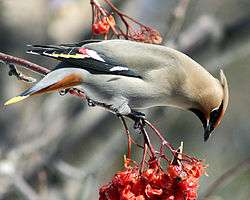
The waxwings are a group of birds with soft silky plumage and unique red tips to some of the wing feathers. In the Bohemian and cedar waxwings, these tips look like sealing wax and give the group its name. These are arboreal birds of northern forests. They live on insects in summer and berries in winter. There are 3 species worldwide and 1 species which occurs in Pakistan.
- Bohemian waxwing, Bombycilla garrulus (A)
Grey hypocolius
Order: Passeriformes Family: Hypocoliidae
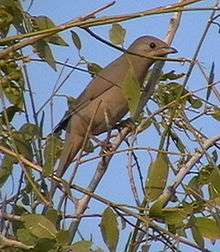
The grey hypocolius is a small Middle Eastern bird with the shape and soft plumage of a waxwing. They are mainly a uniform grey colour except the males have a black triangular mask around their eyes.
- Hypocolius, Hypocolius ampelinus (A)
Dippers
Order: Passeriformes Family: Cinclidae
.jpg)
Dippers are a group of perching birds whose habitat includes aquatic environments in the Americas, Europe and Asia. They are named for their bobbing or dipping movements. There are 5 species worldwide and 2 species which occur in Pakistan.
- White-throated dipper, Cinclus cinclus
- Brown dipper, Cinclus pallasii
Wrens
Order: Passeriformes Family: Troglodytidae
The wrens are mainly small and inconspicuous except for their loud songs. These birds have short wings and thin down-turned bills. Several species often hold their tails upright. All are insectivorous. There are 80 species worldwide (of which all but one are New World species) and 1 species which occurs in Pakistan.
- Eurasian wren, Troglodytes troglodytes
Accentors
Order: Passeriformes Family: Prunellidae

The accentors are in the only bird family, Prunellidae, which is completely endemic to the Palearctic. They are small, fairly drab species superficially similar to sparrows. There are 13 species worldwide and 6 species which occur in Pakistan.
- Alpine accentor, Prunella collaris
- Himalayan accentor, Prunella himalayana
- Robin accentor, Prunella rubeculoides
- Rufous-breasted accentor, Prunella strophiata
- Brown accentor, Prunella fulvescens (A)
- Black-throated accentor, Prunella atrogularis
Thrushes and allies
Order: Passeriformes Family: Turdidae

The thrushes are a group of passerine birds that occur mainly in the Old World. They are plump, soft plumaged, small to medium-sized insectivores or sometimes omnivores, often feeding on the ground. Many have attractive songs.
- Orange-headed thrush, Geokichla citrina
- Plain-backed thrush, Zoothera mollissima
- Scaly thrush, Zoothera dauma
- Tickell's thrush, Turdus unicolor
- Black-breasted thrush, Turdus dissimilis
- White-collared blackbird, Turdus albocinctus
- Grey-winged blackbird, Turdus boulboul
- Tibetan blackbird, Turdus maximus
- Chestnut thrush, Turdus rubrocanus
- Dark-throated thrush, Turdus ruficollis
- Dusky thrush, Turdus naumanni
- Redwing, Turdus iliacus
- Song thrush, Turdus philomelos
- Mistle thrush, Turdus viscivorus
Cisticolas and allies
Order: Passeriformes Family: Cisticolidae

The Cisticolidae are warblers found mainly in warmer southern regions of the Old World. They are generally very small birds of drab brown or grey appearance found in open country such as grassland or scrub. There are 111 species worldwide and 11 species which occur in Pakistan.
- Zitting cisticola, Cisticola juncidis
- Rufous-vented prinia, Prinia burnesii
- Striated prinia, Prinia criniger
- Grey-crowned prinia, Prinia cinereocapilla
- Rufous-fronted prinia, Prinia buchanani
- Grey-breasted prinia, Prinia hodgsonii
- Graceful prinia, Prinia gracilis
- Jungle prinia, Prinia sylvatica
- Yellow-bellied prinia, Prinia flaviventris
- Plain prinia, Prinia inornata
Streaked scrub warbler
Order: Passeriformes Family: Scotocercidae
- Streaked scrub warbler, Scotocerca inquieta
Cettid warblers
Order: Passeriformes Family: Cettiidae
- Brownish-flanked bush warbler, Cettia fortipes
- Cetti's warbler, Cettia cetti
Locustellid warblers
Order: Passeriformes Family: Locustellidae
- Long-billed bush warbler, Locustella major
- Grasshopper warbler, Locustella naevia
- Striated grassbird, Megalurus palustris
- Bristled grassbird, Chaetornis striatus
Acrocephalid warblers
Order: Passeriformes Family: Acrocephalidae
_W_IMG_6807.jpg)
- Moustached warbler, Acrocephalus melanopogon
- Paddyfield warbler, Acrocephalus agricola
- Blunt-winged warbler, Acrocephalus concinens
- Eurasian reed warbler, Acrocephalus scirpaceus
- Blyth's reed warbler, Acrocephalus dumetorum
- Great reed warbler, Acrocephalus arundinaceus
- Clamorous reed warbler, Acrocephalus stentoreus
- Booted warbler, Iduna caligata
- Sykes's warbler, Iduna rama
- Upcher's warbler, Hippolais languida
Phylloscopid warblers
Order: Passeriformes Family: Phylloscopidae

- Willow warbler, Phylloscopus trochilus
- Common chiffchaff, Phylloscopus collybita
- Mountain chiffchaff, Phylloscopus sindianus
- Plain leaf warbler, Phylloscopus neglectus
- Tickell's leaf warbler, Phylloscopus affinis
- Sulphur-bellied warbler, Phylloscopus griseolus
- Pale-rumped warbler, Phylloscopus chloronotus
- Brooks's leaf warbler, Phylloscopus subviridis
- Yellow-browed warbler, Phylloscopus inornatus
- Hume's leaf warbler, Phylloscopus humei
- Greenish warbler, Phylloscopus trochiloides
- Large-billed leaf warbler, Phylloscopus magnirostris
- Tytler's leaf warbler, Phylloscopus tytleri
- Western crowned leaf warbler, Phylloscopus occipitalis
- Blyth's leaf warbler, Phylloscopus reguloides
- Green-crowned warbler, Seicercus burkii
- Grey-hooded warbler, Seicercus xanthoschistos
- Whistler's warbler, Seicercus whistleri
Old World warblers
Order: Passeriformes Family: Sylviidae
The family Sylviidae is a group of small insectivorous passerine birds. They mainly occur as breeding species, as the common name implies, in Europe, Asia and, to a lesser extent, Africa. Most are of generally undistinguished appearance, but many have distinctive songs.
- Greater whitethroat, Sylvia communis
- Lesser whitethroat, Sylvia curruca
- Small whitethroat, Sylvia minula
- Hume's whitethroat, Sylvia althaea
- Asian desert warbler, Sylvia nana
- Barred warbler, Sylvia nisoria
- Eastern Orphean warbler, Sylvia crassirostris
- Menetries's warbler, Sylvia mystacea
- Yellow-eyed babbler, Chrysomma sinense
- Jerdon's babbler, Chrysomma altirostre
Old World flycatchers
Order: Passeriformes Family: Muscicapidae
-2.jpg)
Old World flycatchers are a large group of small passerine birds native to the Old World. They are mainly small arboreal insectivores. The appearance of these birds is highly varied, but they mostly have weak songs and harsh calls.
- Common rock thrush, Monticola saxatilis
- Blue-capped rock thrush, Monticola cinclorhynchus
- Chestnut-bellied rock thrush, Monticola rufiventris
- Blue rock thrush, Monticola solitarius
- Blue whistling thrush, Myophonus caeruleus
- Spotted flycatcher, Muscicapa striata
- Siberian flycatcher, Muscicapa sibirica
- Rusty-tailed flycatcher, Muscicapa ruficauda
- Red-breasted flycatcher, Ficedula parva
- Taiga flycatcher, Ficedula albicilla (A)
- Kashmir flycatcher, Ficedula subrubra
- Ultramarine flycatcher, Ficedula superciliaris
- Slaty-blue flycatcher, Ficedula tricolor
- Verditer flycatcher, Eumyias thalassina
- Rufous-bellied niltava, Niltava sundara
- Common nightingale, Luscinia megarhynchos (A)
- White-tailed rubythroat, Luscinia pectoralis
- Bluethroat, Luscinia svecica
- Indian blue robin, Luscinia brunnea
- White-bellied redstart, Luscinia phaenicuroides
- Himalayan bluetail, Tarsiger rufilatus
- Golden bush robin, Tarsiger chrysaeus
- Rufous-tailed scrub robin, Cercotrichas galactotes
- White-rumped shama, Copsychus malabaricus
- Indian robin, Saxicoloides fulicata
- Rufous-backed redstart, Phoenicurus erythronota
- Blue-capped redstart, Phoenicurus caeruleocephalus
- Black redstart, Phoenicurus ochruros
- Common redstart, Phoenicurus phoenicurus (A)
- White-winged redstart, Phoenicurus erythrogaster
- Blue-fronted redstart, Phoenicurus frontalis
- White-capped redstart, Chaimarrornis leucocephalus
- Plumbeous redstart, Rhyacornis fuliginosus
- Little forktail, Enicurus scouleri
- Spotted forktail, Enicurus maculatus
- Siberian stonechat, Saxicola maurus
- White-browed bushchat, Saxicola macrorhynchus
- White-tailed stonechat, Saxicola leucurus
- Pied bushchat, Saxicola caprata
- Grey bushchat, Saxicola ferreus
- Hooded wheatear, Oenanthe monacha
- Hume's wheatear, Oenanthe alboniger
- Northern wheatear, Oenanthe oenanthe
- Mourning wheatear, Oenanthe lugens
- Finsch's wheatear, Oenanthe finschii
- Variable wheatear, Oenanthe picata
- Pied wheatear, Oenanthe pleschanka
- Red-tailed wheatear, Oenanthe xanthoprymna
- Desert wheatear, Oenanthe deserti
- Isabelline wheatear, Oenanthe isabellina
- Brown rock chat, Cercomela fusca
Fantails
Order: Passeriformes Family: Rhipiduridae
_on_Vilaiti_Keekar_(Prosopis_juliflora)_at_Sindhrot_near_Vadodara%2C_Gujrat_Pix_146.jpg)
The fantails are small insectivorous birds which are specialist aerial feeders.
- White-throated fantail, Rhipidura albicollis
- White-browed fantail, Rhipidura aureola
Fairy flycatchers
Order: Passeriformes Family: Stenostiridae
- Yellow-bellied fantail, Chelidorhynx hypoxantha
- Grey-headed canary flycatcher, Culicicapa ceylonensis
Monarch flycatchers
Order: Passeriformes Family: Monarchidae

The monarch flycatchers are small to medium-sized insectivorous passerines which hunt by flycatching. There are 99 species worldwide and 1 species which occurs in Pakistan.
- Indian paradise flycatcher, Terpsiphone paradisi
Laughingthrushes
Order: Passeriformes Family: Leiothrichidae
_in_Hodal%2C_Haryana_W2_IMG_6245.jpg)
_at_Hodal_Iws_IMG_1034.jpg)
- White-throated laughingthrush, Garrulax albogularis
- Rufous-chinned laughingthrush, Garrulax rufogularis
- Streaked laughingthrush, Garrulax lineatus
- Variegated laughingthrush, Garrulax variegatus
- Chestnut-crowned laughingthrush, Garrulax erythrocephalus
- Common babbler, Turdoides caudatus
- Afghan babbler, Turdoides huttoni
- Striated babbler, Turdoides earlei
- Large grey babbler, Turdoides malcolmi (A)
- Jungle babbler, Turdoides striatus
- Red-billed leiothrix, Leiothrix lutea
- Rufous sibia, Heterophasia capistrata
Ground babblers
Order: Passeriformes Family: Pellorneidae
- Puff-throated babbler, Pellorneum ruficeps
Babblers
Order: Passeriformes Family: Timaliidae
The babblers, or timaliids, are somewhat diverse in size and colouration, but are characterised by soft fluffy plumage.
- Spot-breasted scimitar babbler, Pomatorhinus erythrocnemis
- Rusty-cheeked scimitar babbler, Pomatorhinus erythrogenys
- Black-chinned babbler, Stachyridopsis pyrrhops
Vireos
Order: Passeriformes Family: Vireonidae
- Himalayan shrike-babbler, Pteruthius flaviscapis
- Green shrike-babbler, Pteruthius xanthochlorus
Bearded reedling
Order: Passeriformes Family: Panuridae
- Bearded reedling, Panurus biarmicus (A)
Long-tailed tits
Order: Passeriformes Family: Aegithalidae
_-on_branch.jpg)
Long-tailed tits are a group of small passerine birds with medium to long tails. They make woven bag nests in trees. Most eat a mixed diet which includes insects.
- White-browed tit-warbler, Leptopoecile sophiae
- White-cheeked tit, Aegithalos leucogenys
- Black-throated tit, Aegithalos concinnus
- White-throated tit, Aegithalos niveogularis
Chickadees and titmice
Order: Passeriformes Family: Paridae

The Paridae are mainly small stocky woodland species with short stout bills. Some have crests. They are adaptable birds, with a mixed diet including seeds and insects. There are 10 species which have been recorded in Pakistan.
- Black-breasted tit, Periparus rufonuchalis
- Rufous-vented tit, Periparus rubidiventris
- Black-crested tit or spot-winged tit, Periparus melanolophus
- Grey-crested tit, Lophophanes dichrous
- Cinereous tit, Parus Cinereus
- Green-backed tit, Parus monticolus
- Black-lored tit, Parus xanthogenys
- Azure tit, Cyanistes cyanus (A)
- Yellow-breasted tit, Cyanistes flavipectus
- Fire-capped tit, Cephalopyrus flammiceps
Nuthatches
Order: Passeriformes Family: Sittidae

Nuthatches are small woodland birds. They have the unusual ability to climb down trees head first, unlike other birds which can only go upwards. Nuthatches have big heads, short tails and powerful bills and feet. There are 24 species worldwide and 5 species which occur in Pakistan.
- Chestnut-bellied nuthatch, Sitta castanea
- Kashmir nuthatch, Sitta cashmirensis
- White-cheeked nuthatch, Sitta leucopsis
- Persian nuthatch or eastern rock nuthatch, Sitta tephronota
Wallcreeper
Order: Passeriformes Family: Tichodromidae
The wallcreeper is a small bird related to the nuthatch family, which has stunning crimson, grey and black plumage.
- Wallcreeper, Tichodroma muraria
Treecreepers
Order: Passeriformes Family: Certhiidae
Treecreepers are small woodland birds, brown above and white below. They have thin pointed down-curved bills, which they use to extricate insects from bark. They have stiff tail feathers, like woodpeckers, which they use to support themselves on vertical trees.
- Hodgson's treecreeper, Certhia hodgsoni
- Bar-tailed treecreeper, Certhia himalayana
Penduline tits
Order: Passeriformes Family: Remizidae
The penduline tits are a group of small passerine birds related to the true tits. They are insectivores. There are 3 species which have been recorded in Pakistan.
- Eurasian penduline tit, Remiz pendulinus
- Black-headed penduline tit, Remiz macronyx
- White-crowned penduline tit, Remiz coronatus
Sunbirds and spiderhunters
Order: Passeriformes Family: Nectariniidae

The sunbirds and spiderhunters are very small passerine birds which feed largely on nectar, although they will also take insects, especially when feeding young. Flight is fast and direct on their short wings. Most species can take nectar by hovering like a hummingbird, but usually perch to feed. There are 131 species worldwide and 3 species which occur in Pakistan.
- Purple sunbird, Cinnyris asiaticus
- Mrs. Gould's sunbird, Aethopyga gouldiae
- Crimson sunbird, Aethopyga siparaja
Flowerpeckers
Order: Passeriformes Family: Dicaeidae
The flowerpeckers are very small, stout, often brightly coloured birds, with short tails, short thick curved bills and tubular tongues. There are 44 species worldwide and 2 species which occur in Pakistan.
- Thick-billed flowerpecker, Dicaeum agile
White-eyes
Order: Passeriformes Family: Zosteropidae
The white-eyes are small and mostly undistinguished, their plumage above being generally some dull colour like greenish-olive, but some species have a white or bright yellow throat, breast or lower parts, and several have buff flanks. As their name suggests, many species have a white ring around each eye. There are 96 species worldwide and 1 species which occurs in Pakistan.
- Oriental white-eye, Zosterops palpebrosus
Old World orioles
Order: Passeriformes Family: Oriolidae
_in_Kolkata_I_IMG_7603.jpg)
The Old World orioles are colourful passerine birds. They are not related to the New World orioles. There are 29 species worldwide and 1 species which occurs in Pakistan.
- Indian golden oriole, Oriolus kundoo
Shrikes
Order: Passeriformes Family: Laniidae

Shrikes are passerine birds known for their habit of catching other birds and small animals and impaling the uneaten portions of their bodies on thorns. A typical shrike's beak is hooked, like a bird of prey.
- Red-backed shrike, Lanius collurio
- Isabelline shrike, Lanius isabellinus
- Red-tailed shrike, Lanius phoenicuroides
- Brown shrike, Lanius cristatus
- Bay-backed shrike, Lanius vittatus
- Long-tailed shrike, Lanius schach
- Grey-backed shrike, Lanius tephronotus
- Northern shrike, Lanius excubitor
- Southern grey shrike, Lanius meridionalis
- Lesser grey shrike, Lanius minor (A)
Woodshrikes
Order: Passeriformes Family: Tephrodornithidae
- Common woodshrike, Tephrodornis pondicerianus
Drongos
Order: Passeriformes Family: Dicruridae

The drongos are mostly black or dark grey in colour, sometimes with metallic tints. They have long forked tails, and some Asian species have elaborate tail decorations. They have short legs and sit very upright when perched, like a shrike. They flycatch or take prey from the ground. There are 24 species worldwide and 2 species which occur in Pakistan.
- Black drongo, Dicrurus macrocercus
- Ashy drongo, Dicrurus leucophaeus
Crows, jays, ravens and magpies
Order: Passeriformes Family: Corvidae
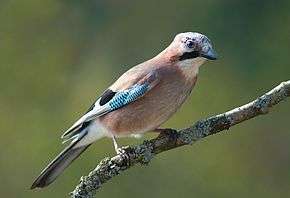

The family Corvidae includes crows, ravens, jays, choughs, magpies, treepies, nutcrackers and ground jays. Corvids are above average in size among the Passeriformes, and some of the larger species show high levels of intelligence.
- Eurasian jay, Garrulus glandarius
- Black-headed jay, Garrulus lanceolatus
- Gold-billed magpie, Urocissa flavirostris
- Rufous treepie, Dendrocitta vagabunda
- Grey treepie, Dendrocitta formosae
- Eurasian magpie, Pica pica
- Eurasian nutcracker, Nucifraga caryocatactes
- Large-spotted nutcracker, Nucifraga multipunctata
- Red-billed chough, Pyrrhocorax pyrrhocorax
- Yellow-billed chough, Pyrrhocorax graculus
- Eurasian jackdaw, Corvus monedula
- House crow, Corvus splendens
- Rook, Corvus frugilegus
- Carrion crow, Corvus corone
- Large-billed crow, Corvus macrorhynchos
- Brown-necked raven, Corvus ruficollis
- Common raven, Corvus corax
- Hooded crow, Corvus cornix
Starlings
Order: Passeriformes Family: Sturnidae
_on_Kapok_(Ceiba_pentandra)_in_Kolkata_W_IMG_4297.jpg)

Starlings are small to medium-sized passerine birds. Their flight is strong and direct and they are very gregarious. Their preferred habitat is fairly open country. They eat insects and fruit. Plumage is typically dark with a metallic sheen.
- Spot-winged starling, Saroglossa spiloptera
- Jungle myna, Acridotheres fuscus
- Bank myna, Acridotheres ginginianus
- Common myna, Acridotheres tristis
- Pied myna, Gracupica contra
- Daurian starling, Agropsar sturninus (A)
- Chestnut-tailed starling, Sturnia malabarica
- Brahminy starling, Sturnia pagodarum
- Rosy starling, Pastor roseus
- European starling, Sturnus vulgaris
Weavers and allies
Order: Passeriformes Family: Ploceidae
The weavers are small passerine birds related to the finches. They are seed-eating birds with rounded conical bills. The males of many species are brightly coloured, usually in red or yellow and black, some species show variation in colour only in the breeding season. There are 116 species worldwide and 2 species which occur in Pakistan.
- Streaked weaver, Ploceus manyar
- Baya weaver, Ploceus philippinus
Waxbills and allies
Order: Passeriformes Family: Estrildidae
.jpg)
The estrildid finches are small passerine birds of the Old World tropics and Australasia. They are gregarious and often colonial seed eaters with short thick but pointed bills. They are all similar in structure and habits, but have wide variation in plumage colours and patterns. There are 141 species worldwide and 4 species which occur in Pakistan.
- Red avadavat, Amandava amandava
- White-throated munia, Euodice malabarica
- Nutmeg mannikin, Lonchura punctulata
- Spice finch, Lonchura punctulata
Buntings, sparrows, seedeaters and allies
Order: Passeriformes Family: Emberizidae

The emberizids are a large family of passerine birds. They are seed-eating birds with distinctively shaped bills. In Europe, most species are called buntings. In North America, most of the species in this family are known as sparrows, but these birds are not closely related to the Old World sparrows which are in the family Passeridae. Many emberizid species have distinctive head patterns.
- Crested bunting, Melophus lathami
- Pine bunting, Emberiza leucocephalos
- Rock bunting, Emberiza cia
- Godlewski's bunting, Emberiza godlewskii
- Grey-hooded bunting, Emberiza buchanani
- Ortolan bunting, Emberiza hortulana (A)
- Chestnut-breasted bunting, Emberiza stewarti
- Striolated bunting, Emberiza striolata
- Chestnut-eared bunting, Emberiza fucata
- Little bunting, Emberiza pusilla
- Yellow-breasted bunting, Emberiza aureola
- Chestnut bunting, Emberiza rutila
- Black-headed bunting, Emberiza melanocephala
- Red-headed bunting, Emberiza bruniceps
- Reed bunting, Emberiza schoeniclus
- Corn bunting, Emberiza calandra
Siskins, crossbills and allies
Order: Passeriformes Family: Fringillidae

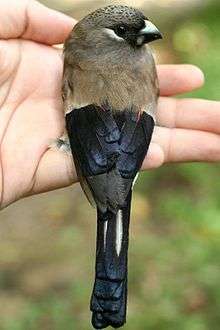
Finches are seed-eating passerine birds, that are small to moderately large and have a strong beak, usually conical and in some species very large. All have twelve tail feathers and nine primaries. These birds have a bouncing flight with alternating bouts of flapping and gliding on closed wings, and most sing well. There are 137 species worldwide and 31 species which occur in Pakistan.
- Common chaffinch, Fringilla coelebs
- Brambling, Fringilla montifringilla
- Plain mountain-finch, Leucosticte nemoricola
- Black-headed mountain-finch, Leucosticte brandti
- Dark-breasted rosefinch, Carpodacus nipalensis
- Common rosefinch, Carpodacus erythrinus
- Beautiful rosefinch, Carpodacus pulcherrimus
- Pink-browed rosefinch, Carpodacus rhodochrous
- White-browed rosefinch, Carpodacus thura
- Red-mantled rosefinch, Carpodacus rhodochlamys
- Caucasian great rosefinch, Carpodacus rubicilla
- Red-fronted rosefinch, Carpodacus puniceus
- Red crossbill, Loxia curvirostra [A]
- Yellow-breasted greenfinch, Chloris spinoides
- European goldfinch, Carduelis carduelis (A)
- Twite, Linaria flavirostris
- Common linnet, Linaria cannabina
- Fire-fronted serin, Serinus pusillus
- Brown bullfinch, Pyrrhula nipalensis
- Orange bullfinch, Pyrrhula aurantiaca
- Red-headed bullfinch, Pyrrhula erythrocephala
- Hawfinch, Coccothraustes coccothraustes
- Black-and-yellow grosbeak, Mycerobas icterioides
- Collared grosbeak, Mycerobas affinis
- Spot-winged grosbeak, Mycerobas melanozanthos
- White-winged grosbeak, Mycerobas carnipes
- Spectacled finch, Callacanthis burtoni
- Crimson-winged finch, Rhodopechys sanguinea
- Mongolian finch, Rhodopechys mongolica
- Trumpeter finch, Bucanetes githaginea
- Desert finch, Rhodospiza obsoleta
Sparrows
Order: Passeriformes Family: Passeridae

-_Male_at_Sultanpur_I_Picture_178.jpg)
Sparrows are small passerine birds. In general, sparrows tend to be small, plump, brown or grey birds with short tails and short powerful beaks. Sparrows are seed eaters, but they also consume small insects. There are 35 species worldwide and 10 species which occur in Pakistan.
- House sparrow, Passer domesticus
- Spanish sparrow, Passer hispaniolensis
- Sind sparrow, Passer pyrrhonotus
- Russet sparrow, Passer rutilans
- Dead Sea sparrow, Passer moabiticus
- Eurasian tree sparrow, Passer montanus
- Chestnut-shouldered petronia, Petronia xanthocollis
- Rock petronia, Petronia petronia
- Pale rockfinch, Carpospiza brachydactyla
- White-winged snowfinch, Montifringilla nivalis
See also
Notes
- ↑ IUCN (2008) Cited in Birdlife International Website
| Wikimedia Commons has media related to Birds of Pakistan. |
References
- Clements, James F. (2000). Birds of the World: a Checklist. Cornell University Press. ISBN 0-934797-16-1.
- Lepage, Denis. "Checklist of birds of Pakistan". Bird Checklists of the World. Avibase. Retrieved 27 April 2007.
- Mirza, Zahid Baig (2007). A field guide to Birds of Pakistan. Lahore: Bookland. ISBN 969-8283-46-3.
_with_nesting_material_W_IMG_2806.jpg)
